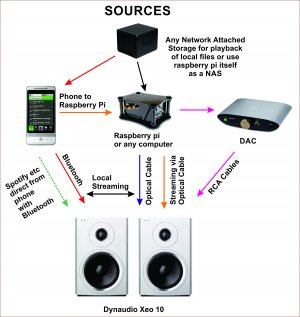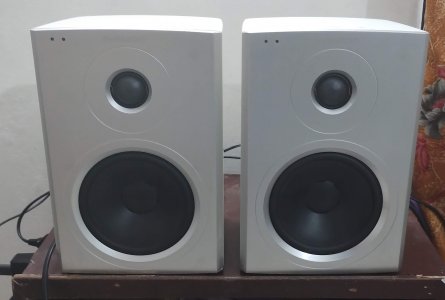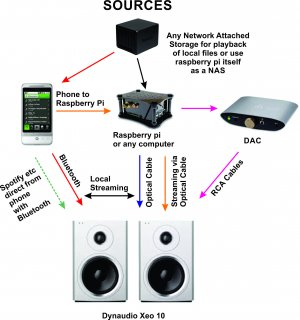In the fag-end of last year (2021), I purchased a pair of active monitors (Presonus Eris E66) after giving away my Infinity Reference which had given musical bliss for many years. But after the initial phase, I just could not warm up to the music presentation of the Presonus in spite of lots of jugglery, re-positioning etc.
The listening came down and after about 2 months, totally stopped.
I then put them on sale locally and it was gleefully picked up by a studio guy as it was at half the retail price.
Then after a couple months with some ear issues subsiding, I moved on to my headphones, the closed ATH M50X with Bluetooth interface during walks and open back Philips/Sennheiser while at home.
But the urge to own a stereo setup was always lingering and after lots of deliberation, I decided to get a pair of Elac Debut B6 (the original version as I like their presentation a lot) and also as I had one good Class AB 100-watt full amplifier kit on hand to build.
But getting the 1st version was a challenge as stock was sparce and nothing was on sale in the used market either. I kept in contact with the Kripa Electronics Area Manager in Chennai (South India). After around 6 weeks, he told me a pair was available with a dealer in Jaipur and it finally reached me on Sept. 16, billed through a dealer from Chennai as is their trade policy.
I was using the Elac with couple amps at my disposal like the Fatman Hybrid (that had come from Bangalore to me for repairs, and is still with me) and two high-end car audio amps (Audison LRX and Helix). Of course, in terms of dynamics, the Audision blows the Fatman away, but Fatman is quite musical once it warms up.
Even as I was enjoying my Elacs and my daily listening was scaling up after almost 6 months, I got a chance to listen to a pair of active speakers, less than half the size of the Elacs.
These Dynaudio Xeo 10 active and wireless speakers, in mint condition, were available for sale at a clip I could take a call on buying.
It has an inbuilt Burr Brown DAC (only optical (toslink) input and bluetooth with aptx codec support) + two analogue inputs (one pair aux and one 3.5 mm for phones and other low output devices). One speaker is the master with the DAC built-in and the other is slave with no wires and connected to the master wirelessly (2.4 ghz), 24bit/96khz. There is a switch to choose either speaker as left/right depending on user’s placement need. It comes with a remote, but the owner lost the remote for this pair.
As I knew the seller gentleman, got the liberty to listen to them for a couple days and took the bite of owning them. As for remote, I used an android application (IR Remote Creator) to build to build a fully functional remote as hex codes for the original remote are available on the Dynaudio website.
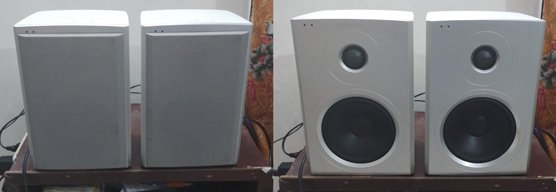
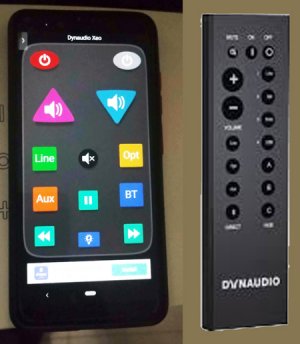
The phone-app remote The original
These speakers, employ full dual digital amplification (65-watt RMS digital amplification separately for tweeters and woofers) and DSP-based active crossovers. The tweeters are crossed at 5000hz as per Dynaudio specs. So, for both analogue inputs, there is an ADC (Analogue to Digital) conversion for feeding the signal to the inbuilt DSP.
Since both speakers have their own amplifiers, it is a full dual mono design.
The speakers are dead silent with no hum or feedback.
The Xeo 10 maybe small with a small footprint, but sound quite big, articulate, bass is to my liking, exceptional mids and airy highs, very good depth and a wide soundstage.
Though active, these are not designed with studio professionals in mind and mainly for the end users.
Here is my take on active speakers/studio monitors:
Some pros:
1. They are designed by companies targeting the music production industry and are hence built on proper technical parameters and measurements.
2. Though they usually have a reasonably flat frequency which is usually not the most pleasing curve for human ears, most studio monitors are provided with tone settings to tweak the output
3. You don’t need an amplifier which helps in avoiding clutter and matching issues.
4. Most monitors offer balanced inputs which has the lower noise floor and the highest gain.
5.Active designs (assuming the monitor employs digital crossover) are inherently superior to passive design as there are no passive crossover components to constrain the power and to some extent the dynamics.
6. The reproduction usually will be closest to what is in the music with minimal colouration.
Some cons:
1. One is stuck with the power design as there is no way to upgrade the amp.
2. They generally have poor off axis response so may not be suitable for larger rooms or rooms that resonate too much
3. They are usually more extended in frequency response which maybe fatiguing for extended listening
4. Accuracy is not often what ears like
5. Amps being built into the cabinets, they are prone to hum unless well shielded which is expensive to implement. Most entry to mid level monitors may have a slight hum. They are also prone to failure.
6. Cabinets are not that well build with entry level monitors and will resonate, so isolation and good stands are paramount to contain this deficiency.
7. If amp dies, the speaker is as good as dead and unusable
8. Generally being high gain devices, they will usually not pair well with home audio preamps which usually feature a higher gain.
9. They usually have lower input impedance (10000 to 25000 ohms), so one has to be careful while choosing a preamp.
Now coming back to the Dynaudio Xeo, the biggest plus for me other than the sound quality was no need for a DAC, preamp, interconnects or speaker cables. All that goes into the Dynaudio are the power cables and I can just use Bluetooth to stream the music from music apps like spotify, tidal etc. or local files from a NAS using my phone.
OR
Additionally, use a source like raspberry pi with a digi HAT like Hifiberry digi2 pro, JustBoom digi HAT or Allo Digione Signature with a Coax to Toslink converter and connect to the Dynaudio Xeo with a toslink cable.
I am presently using raspberry pi4 with Allo Digione One Signature with a coax to toslink converter to feed the Xeos and the pi4 also serves as a network medium for my phone to access the files to play from my phone via Bluetooth using aptx protocol.
The Bluetooth implementation in the Xeos is excellent and I can just use that, but I also like native playback using the optical cable with digione signature as transport.
Now thinking of getting a Digi HAT like JustBoom of Hifiberry to get a direct toslink output on the raspberry pi instead of using a coax to optical converter
The listening came down and after about 2 months, totally stopped.
I then put them on sale locally and it was gleefully picked up by a studio guy as it was at half the retail price.
Then after a couple months with some ear issues subsiding, I moved on to my headphones, the closed ATH M50X with Bluetooth interface during walks and open back Philips/Sennheiser while at home.
But the urge to own a stereo setup was always lingering and after lots of deliberation, I decided to get a pair of Elac Debut B6 (the original version as I like their presentation a lot) and also as I had one good Class AB 100-watt full amplifier kit on hand to build.
But getting the 1st version was a challenge as stock was sparce and nothing was on sale in the used market either. I kept in contact with the Kripa Electronics Area Manager in Chennai (South India). After around 6 weeks, he told me a pair was available with a dealer in Jaipur and it finally reached me on Sept. 16, billed through a dealer from Chennai as is their trade policy.
I was using the Elac with couple amps at my disposal like the Fatman Hybrid (that had come from Bangalore to me for repairs, and is still with me) and two high-end car audio amps (Audison LRX and Helix). Of course, in terms of dynamics, the Audision blows the Fatman away, but Fatman is quite musical once it warms up.
Even as I was enjoying my Elacs and my daily listening was scaling up after almost 6 months, I got a chance to listen to a pair of active speakers, less than half the size of the Elacs.
These Dynaudio Xeo 10 active and wireless speakers, in mint condition, were available for sale at a clip I could take a call on buying.
It has an inbuilt Burr Brown DAC (only optical (toslink) input and bluetooth with aptx codec support) + two analogue inputs (one pair aux and one 3.5 mm for phones and other low output devices). One speaker is the master with the DAC built-in and the other is slave with no wires and connected to the master wirelessly (2.4 ghz), 24bit/96khz. There is a switch to choose either speaker as left/right depending on user’s placement need. It comes with a remote, but the owner lost the remote for this pair.
As I knew the seller gentleman, got the liberty to listen to them for a couple days and took the bite of owning them. As for remote, I used an android application (IR Remote Creator) to build to build a fully functional remote as hex codes for the original remote are available on the Dynaudio website.


The phone-app remote The original
These speakers, employ full dual digital amplification (65-watt RMS digital amplification separately for tweeters and woofers) and DSP-based active crossovers. The tweeters are crossed at 5000hz as per Dynaudio specs. So, for both analogue inputs, there is an ADC (Analogue to Digital) conversion for feeding the signal to the inbuilt DSP.
Since both speakers have their own amplifiers, it is a full dual mono design.
The speakers are dead silent with no hum or feedback.
The Xeo 10 maybe small with a small footprint, but sound quite big, articulate, bass is to my liking, exceptional mids and airy highs, very good depth and a wide soundstage.
Though active, these are not designed with studio professionals in mind and mainly for the end users.
Here is my take on active speakers/studio monitors:
Some pros:
1. They are designed by companies targeting the music production industry and are hence built on proper technical parameters and measurements.
2. Though they usually have a reasonably flat frequency which is usually not the most pleasing curve for human ears, most studio monitors are provided with tone settings to tweak the output
3. You don’t need an amplifier which helps in avoiding clutter and matching issues.
4. Most monitors offer balanced inputs which has the lower noise floor and the highest gain.
5.Active designs (assuming the monitor employs digital crossover) are inherently superior to passive design as there are no passive crossover components to constrain the power and to some extent the dynamics.
6. The reproduction usually will be closest to what is in the music with minimal colouration.
Some cons:
1. One is stuck with the power design as there is no way to upgrade the amp.
2. They generally have poor off axis response so may not be suitable for larger rooms or rooms that resonate too much
3. They are usually more extended in frequency response which maybe fatiguing for extended listening
4. Accuracy is not often what ears like
5. Amps being built into the cabinets, they are prone to hum unless well shielded which is expensive to implement. Most entry to mid level monitors may have a slight hum. They are also prone to failure.
6. Cabinets are not that well build with entry level monitors and will resonate, so isolation and good stands are paramount to contain this deficiency.
7. If amp dies, the speaker is as good as dead and unusable
8. Generally being high gain devices, they will usually not pair well with home audio preamps which usually feature a higher gain.
9. They usually have lower input impedance (10000 to 25000 ohms), so one has to be careful while choosing a preamp.
Now coming back to the Dynaudio Xeo, the biggest plus for me other than the sound quality was no need for a DAC, preamp, interconnects or speaker cables. All that goes into the Dynaudio are the power cables and I can just use Bluetooth to stream the music from music apps like spotify, tidal etc. or local files from a NAS using my phone.
OR
Additionally, use a source like raspberry pi with a digi HAT like Hifiberry digi2 pro, JustBoom digi HAT or Allo Digione Signature with a Coax to Toslink converter and connect to the Dynaudio Xeo with a toslink cable.
I am presently using raspberry pi4 with Allo Digione One Signature with a coax to toslink converter to feed the Xeos and the pi4 also serves as a network medium for my phone to access the files to play from my phone via Bluetooth using aptx protocol.
The Bluetooth implementation in the Xeos is excellent and I can just use that, but I also like native playback using the optical cable with digione signature as transport.
Now thinking of getting a Digi HAT like JustBoom of Hifiberry to get a direct toslink output on the raspberry pi instead of using a coax to optical converter


